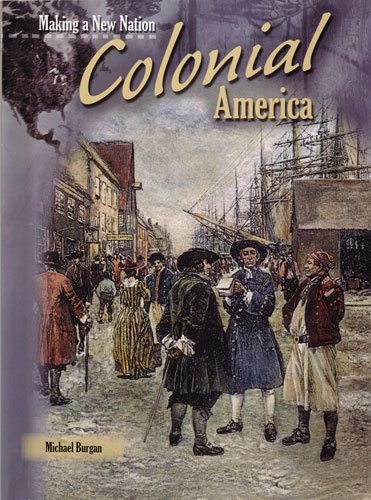-
School in Colonial America
Mark Thomas
Library Binding (Childrens Pr, March 1, 2002)A brief description of schools in colonial America, and what children learned there. K
K
-
Homes in Colonial America
Mark Thomas
Paperback (Childrens Pr, April 1, 2002)Simple text and photographs depict homes in colonial America, describing their interiors, exteriors, and such typical features as fireplaces and outhouses. F
F
-
Slavery in Colonial America
Alison Morretta
Paperback (Cavendish Square, Jan. 15, 2018)Slaves replaced indentured servants as a source of cheap labor in all of the colonies early in the seventeenth century. Slavery was first legalized in Massachusetts. However, economics soon made slavery unnecessary in the North while increasing demand for it in the South. Readers learn from those who lived it, how this increased demand led to the importation of African slaves into the colonies and the expansion of an institution that would threaten to tear a new nation apart.
-
Colonial Life in America
Louis Sabin
Paperback (Troll Communications Llc, Feb. 1, 1986)A brief look at colonial life in Jamestown and in the New England settlements in the early seventeenth century L
L
-
Colonial Food
Verna Fisher, Andrew Christensen
language (Nomad Press, Sept. 1, 2010)Taking young readers on a journey back in time, this dynamic series showcases various aspects of colonial life, from people and clothing to homes and food. Each book contains creative illustrations, interesting facts, highlighted vocabulary words, end-of-book challenges, and sidebars that help children understand the differences between modern and colonial life and inspire them to imagine what it would have been like to grow up in colonial America. The volumes in this series focus on the colonists but also include relevant information about Native Americans, offering a variety of perspectives on life in the colonies.An introduction to colonial eating habits, this historical reference looks at the new foods the colonists discovered when they came to America, the help that they received from friendly Native Americans in growing crops, and how both the colonists and the Native Americans collected enough food to survive.
-
School in Colonial America
Shelley Swanson Sateren
Paperback (Capstone Press, Aug. 1, 2016)Explores the school day of colonial children in the New England, Middle and Southern Colonies. Details the typical schoolteacher and urban and rural schoolhouses. Includes an activity to connect today’s reader with the past. U
U
-
Life in Colonial America
Speare
Library Binding (Random House Childrens Books, Dec. 1, 1963)Stories about daily life in Colonial times.
-
Colonial America
Michael Burgan
Library Binding (Heinemann, Aug. 16, 2006)Why did the European nations set up colonies? What was daily life like for the colonists? How did colonists and Native Americans help each other? North America was a rich land, full of natural resources. European nations raced to set up colonies in order to make use of these resources. The continent's reputation as a land of opportunity attracted thousands of settlers, but life for these colonists was hard and sometimes dangerous. W
W
-
Religion in Colonial America
Jon Butler
eBook (Oxford University Press, May 18, 2000)Many people believe that the piety of the Pilgrims typified early American religion. However, by the 1730s Catholics, Jews, and Africans had joined Native Americans, Puritans, and numerous Protestant denominations in the colonies. Jon Butler launches his narrative with a description of the state of religious affairs in both the Old and New Worlds. He explores the failure of John Winthrop's goal to achieve Puritan perfection, the controversy over Anne Hutchinson's tenacious faith, the evangelizing stamina of ex-slave and Methodist preacher Absalom Jones, and the spiritual resilience of the Catawba Indians. The meeting of these diverse groups and their varied use of music, dance, and ritual produced an unprecedented evolution of religious practice, including the birth of revivals. And through their daily interactions, these Americans created a living foundation for the First Amendment. After Independence their active diversity of faiths led Americans to the groundbreaking idea that government should abandon the use of law to support any religious group and should instead guarantee free exercise of religion for everyone. Religion in American Life explores the evolution, character, and dynamics of organized religion in America from 1500 to the present day. Written by distinguished religious historians, these books weave together the varying stories that compose the religious fabric of the United States, from Puritanism to alternative religious practices. Primary source material coupled with handsome illustrations and lucid text make these books essential in any exploration of Americas diverse nature. Each book includes a chronology, suggestions for further reading, and index.
-
Colonial America
Richard Steins
Library Binding (Heinemann/Raintree, Jan. 1, 2000)Describes the daily life and important events in the American colonies during the time of British rule. W
W
-
Colonial Food
Verna Fisher, Andrew Christensen
language (Nomad Press, Sept. 1, 2010)Taking young readers on a journey back in time, this dynamic series showcases various aspects of colonial life, from people and clothing to homes and food. Each book contains creative illustrations, interesting facts, highlighted vocabulary words, end-of-book challenges, and sidebars that help children understand the differences between modern and colonial life and inspire them to imagine what it would have been like to grow up in colonial America. The volumes in this series focus on the colonists but also include relevant information about Native Americans, offering a variety of perspectives on life in the colonies.An introduction to colonial eating habits, this historical reference looks at the new foods the colonists discovered when they came to America, the help that they received from friendly Native Americans in growing crops, and how both the colonists and the Native Americans collected enough food to survive.
-
Growing Up In Colonial America
Tracy Barrett
Library Binding (Millbrook Press, Oct. 1, 1995)An intimate look at the everyday life of children in seventeenth- and eighteenth-century America contains authentic first-hand accounts, diaries, recipes, letters, and other mementos of youth in a young country. P
P